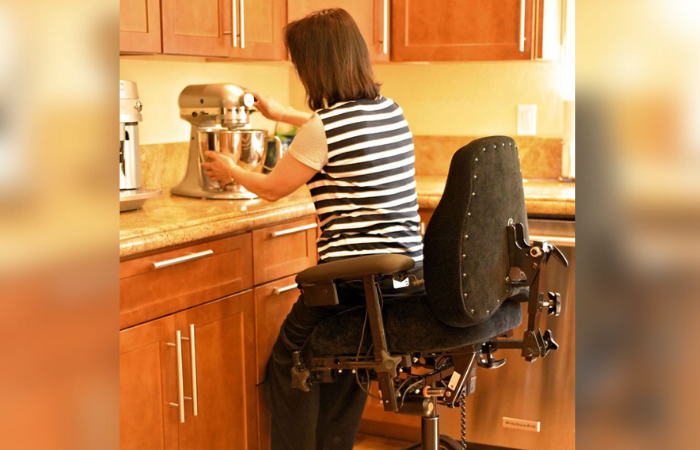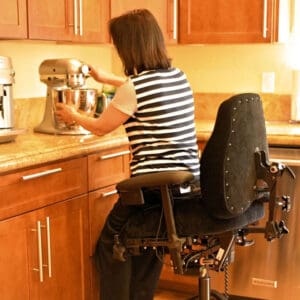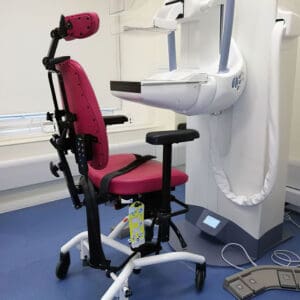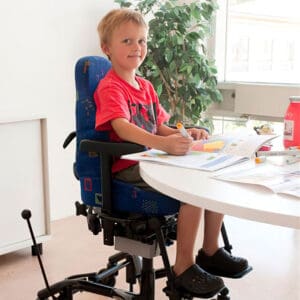
More and more, interior designers are recognizing the importance of creating spaces that are more functional and accessible for people no matter their age and size, or their abilities and disabilities. Not only does form follow function, but it’s simply the right thing to do. The concept is called universal design, and it’s based on the fundamental belief that spaces should be planned to meet the needs of all people who want to use them. Schools, public buildings, workplaces and homes can be inclusive and equipped to serve people with a range of needs if careful consideration is applied to each design.
That’s the ideal scenario. But what happens when spaces aren’t well-suited to individuals living with disabilities? Is there a work-around solution?

Assistive technology and product advancements offer specialized solutions for people with specific requirements. These aids can help people complete everyday tasks that cultivate independence such as getting dressed, grooming, cooking, eating, reading and writing. Adaptive devices can empower children to participate more fully in school while enabling adults to be more effective in the workplace. Innovative equipment can augment mobility and foster inclusion, which can enhance quality of life significantly for individuals living with disabilities. For example, children with disabilities might be left out of doing basic household chores, and these are vital developmental activities that can help build independence, self-esteem, and a sense of responsibility. If a child can’t reach the countertop, he or she can’t be expected to do dishes like the other siblings in the household. Parents may adapt to these limitations by giving this child a basin of water on a lower table to use for washing the dishes. But could there be a better way?
Brian Landmann believed there had to be. His daughter faces challenges with balance and motor coordination, so he went searching for a product to increase her mobility within certain spaces. For years, he Googled key words in his quest to find the perfect device. Eventually, when his daughter was nine years old, he finally discovered a chair in Sweden that seemed to offer the solution. But the manufacturer didn’t ship to the USA, so a friend in Europe bought it and sent it to him.
At first, Landmann was focused on improving his child’s home life. She spent a lot of her time sitting at the kitchen table, and if she wanted to go somewhere else, she had to wait for someone to pick her up and move her. Landmann hoped this would give her more freedom. He recalls how quickly she adapted.
“One of the things my wife and I remember is the first day she had her chair, we both looked in the kitchen where she always sat, and she was gone. We both panicked and jumped up to go look for her. We found her sitting in the chair by the pantry, reaching high into it to get a snack. This was the first time she went anywhere at home by herself.”
It was a great feeling to watch his daughter thriving with her new chair. She began using it all over the house for various activities including playing the piano, cooking and baking, and even watching television, because the chair is more comfortable for her than the couch.

The home experiment was so successful that Landmann’s next mission was to improve his daughter’s opportunity to participate in school. The chair wasn’t portable enough to easily transport between two locations, so Landmann realized she would need another one. This would give her the flexibility to move between spaces, including classrooms, the science lab, the music room, and the cafeteria, without the school having to adapt its tables and chairs in every space to meet her needs. Instead, the portable adaptive device would travel with her from room to room. The school district even agreed to cover the cost of the chair because it was a cost-effective solution when compared with adapting the furniture to fit his daughter’s needs.
“Before getting the chair, she would be in six different classrooms, and they would need a height-adjusted table for every classroom,” Landmann says.
There was no doubt this product had changed his child’s world in a tangible, meaningful way. It was the greatest gift Landmann could give to his daughter.
That was four years ago. Landmann has since founded his Seattle-based company, EMP Living, to bring these chairs to the American market all the way from Sweden, where they are designed and manufactured. He wants to help other children and adults gain the same freedom and flexibility this chair provided to his daughter.

It’s important to note that if a caregiver is not assisting, users of the EMP Living chairs should have some use of their legs for this product to be an effective addition to their lifestyles. If you want to move the chair yourself, you must be able to put one foot on the floor and be able to push. Special wheels that roll more easily are available for those with minimal leg strength.
The chair doesn’t discourage movement – rather it facilitates mobility. It is not designed to be used as a wheelchair, but instead it is used to travel shorter distances inside homes, schools, and workplaces. It is narrower than a wheelchair and equipped with spinner wheels that allow it to move from side to side. It can fit neatly into tight spaces like household bathrooms, and navigate smoothly around obstacles such as between desks in classrooms. It’s not just a chair for sitting. It helps propel its user effectively and efficiently around their environments. It can also be used as a walker, or to transfer its user to various other chairs. The chair can also be lowered to help the person safely complete tasks closer to the floor, such as loading and unloading a washing machine or reaching items in a lower kitchen cabinet. The chair comes with the basics, plus offers a range of options such as manual or electric lift and tilt. Accessories such as footrests, neck rests, seat belts and trunk supports are also available.

“Our chair allows you to do as much as you can with your legs,” Landmann says. He offers a typical example of how someone’s routine morning might go with the help of the EMP Living chair. “You can walk it to the bathroom, check yourself out in the mirror, brush your teeth, put your makeup on, dry your hair, brush your hair, and sit down at your kitchen table and have your coffee.”
While modifying and adapting houses, workspaces and classrooms in myriad ways is one solution for people living with disabilities, the EMP Living chairs offer its users another option for maneuvering through their environments with independence and confidence.
No single product is going to help everybody do everything. But with dedicated dads like Brian Landmann out there searching for the answers, there is no end to the solutions that human beings can discover to help themselves and their loved ones live their very best lives.